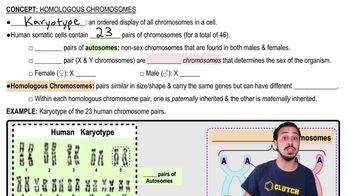Here are the essential concepts you must grasp in order to answer the question correctly.
Chromosomes
Chromosomes are long, thread-like structures made of DNA and proteins that contain genetic information. In humans, there are 23 pairs of chromosomes, totaling 46, with each chromosome carrying numerous genes that dictate various biological functions and traits.
Recommended video:
Genes
Genes are segments of DNA that serve as the basic units of heredity. They encode instructions for the synthesis of proteins, which perform most life functions. The human genome is estimated to contain approximately 20,000 to 25,000 genes, which contribute to the complexity of human biology.
Recommended video:
Human Genome
The human genome is the complete set of genetic information for humans, consisting of all the genes and non-coding sequences in our DNA. It is crucial for understanding human biology, evolution, and the basis of genetic diseases, and it provides insights into the number of genes present in our chromosomes.
Recommended video:
Genomes and Genome Evolution



